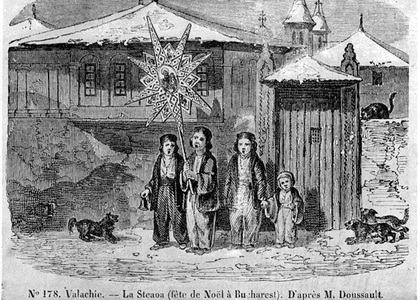> Recommendations

The 'Forerunners' of Christmas, Byzantine Music and Songs to the Star - Traditional Songs, 15th of December
The cycle of Lord`s embodiment contains, in the doxology and the Orthodox hymns, three great feasts, entitled great feasts, designating thus their special importance within the religious year. These are: Christ's Mass (25th of December, the Christmas), The Circumcision of the Lord (1st of January, that overlaps with the Civil New Year and with the Feast of Saint Basil the Great) and The Baptism of Lord (6th of January, the Epiphany). Having Christmas as a point of departure, those three feasts represent the kenotic aspect (κενώ, to void, κένωσις voidage, the decrease of His divine glory) of the embodiment of the Lord Jesus Christ, the Son of God, Who ' rather, he made himself nothing by taking the very nature of a servant, being made in human likeness' (Philippians 2, 7-8). One of the most know hymns of praise brought to the embodiment of Lord is the Canon of The Nativity of Lord, that it is sang at Early Service (the morning service) of this feast of joy and the enlightenment of world. Composed in 18th century, this very large hymnodic poem is assigned to the Saint Cosmas the Hymnographer, who paraphrased in lyrics and music the Christmas sermon of the Saint Gregory of Nazianzus 'Christ is born, glorify Him! Christ in Heaven, greet Him! Christ on earth, raise yourself!' The unspoken sacrament of the Nativity of Lord is present in all the ninth odes of the Canon, while the refrains are permanently reiterated the theological and also the doxological content of the hymnodic poem: 'Praise Him people that was glorified.'
'Make ready, O Bethlehem!'
The Byzantine music represents one of the artistic manifestation forms of the superabundance soul, through which the man has a prayer relationship with God. The Byzantine song is not just music, because it is beyond music: sung prayer, doxology, spiritual feelings and it is the very quintessence form of concrete manifestation of the Orthodox Christianity cult, as an angelic robe of the Church. A representative hymn composition for the liturgical period of the Nativity of Lord is the First Hour, an hymn that is assigned to the Saint Sophrony, the Patriarch of Jerusalem, dating back to the 17th century: 'Make ready, O Bethlehem: let the manger be prepared, let the cave show its welcome. The truth has come, the shadow has passed away; born of a Virgin, God has appeared to men, formed as we are and making godlike the garment He has put on. '
After it crossed the ages, being present in different Byzantine Codices, this song was translated also in the Romanian language, in the 19th century, through the written and oral tradition of Church, by Dimitrie Suceveanu, who realised the liturgical songs collection, entitled 'Idiomelar'. Another Romanian author and translator of the Byzantine songs, that followed Suceveanu, was the Hieromonk Makarije, who 'adapted' in the Romanian language the Greek original songs. In this context we can also add the Troparion of the Nativity of Lord; it represents one of the most known songs of the Orthodox Church: a unitary stanza through which is being concisely evoked, the meaning of the feast: 'Thy Nativity, O Christ, our God, has shown to the world the light of wisdom, for they that worshipped the stars were taught by the star to worship Thee, O Sun of Justice, and to know that from the East of the Highest Thou didst come, O Lord glory to Thee.'
'Three Magi from the East'
In the Romanian Music Culture of the 19th century, the songs to the star were written for the first time in the Anton Pann`s anonymous collection, that was published in many other successive editions during the life of the author, between 1830 and 1848. The tradition of the songs written with Byzantine names by Anton Pann it is an older one; they had been sung even from the 17th century when they were also very popular. In this context it is important to emphasize the difference between the carols and the songs to the star. The carols have a traditional origin and they are sang especially in the traditional Romanian villages, while the songs to the star have a religious origin and they are sang both in the Romanian and European territory. 'Three magi from the east / Travelled towards the star / And they went, just like it's written / Until they reached Jerusalem…'
This is the beginning of the narration, in apocryphal lyrics and in Romanian traditional meter, of the biblical reference about the three magi who wanted to meet the Lord who born in Bethlehem. In the central-European culture, of Roman Catholic Christian tradition, the three kings (or magi, how they are also called) are present in the traditional songs to the star, with musical influences that are attesting the religious songs. These songs are expressing the Catholic hymn influences over the traditional song but also, at the same time, the manner of voice interpretation, on may voices, simple and naturally harmonised.
Therefore, I am inviting you on Tuesday, 15th of December, at 20.30, at the last edition of this year of the 'Traditional Music' programme, to listen to Byzantine songs and songs to the star from the Orthodox and Roman-Catholic cultures, for the expectation of Christmas, this holiday of light, joy, the reconciliation of people with God and with themselves.
Translated by Oana Diaconu
MTTLC, the University of Bucharest , 2nd Year














